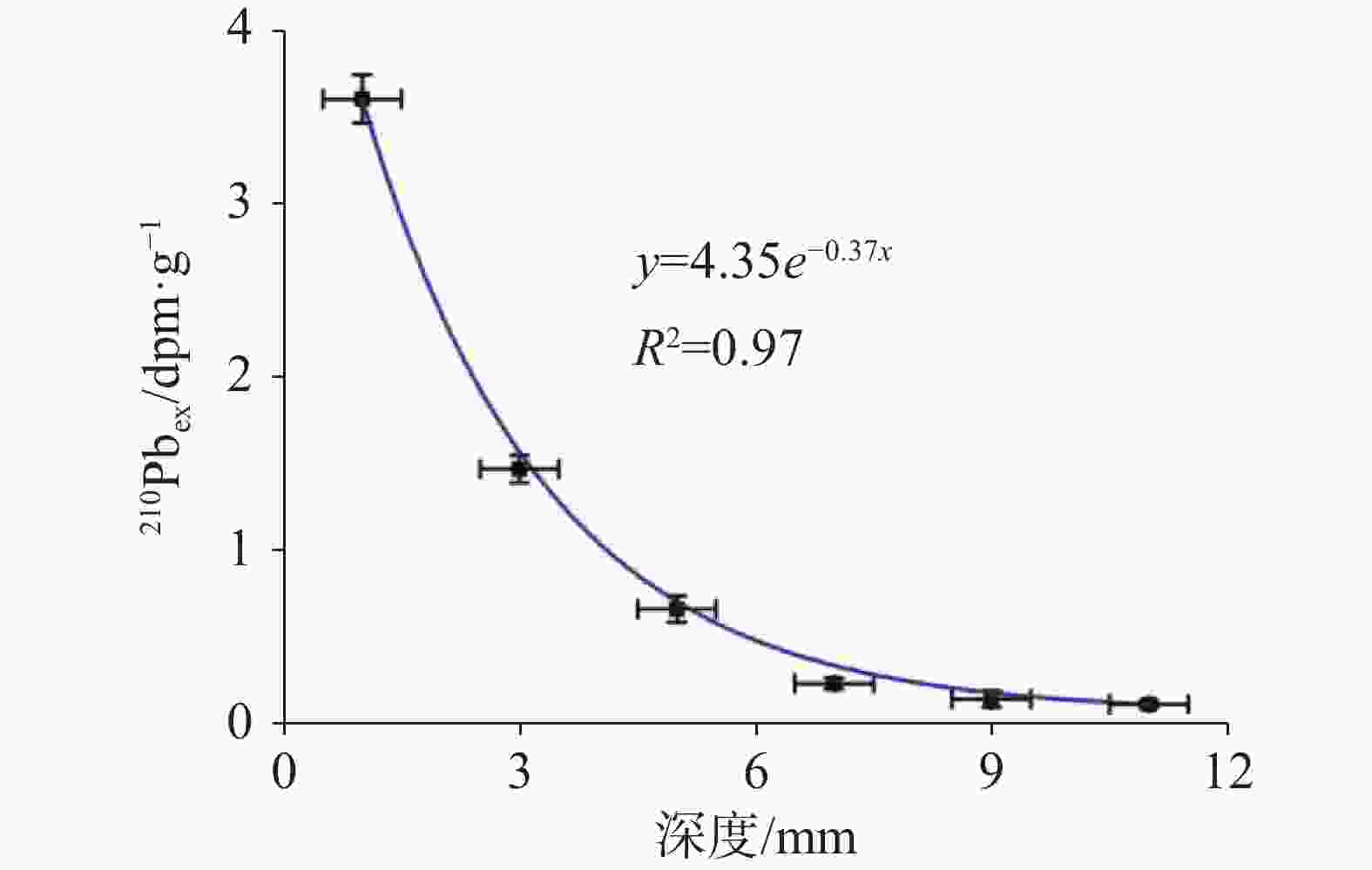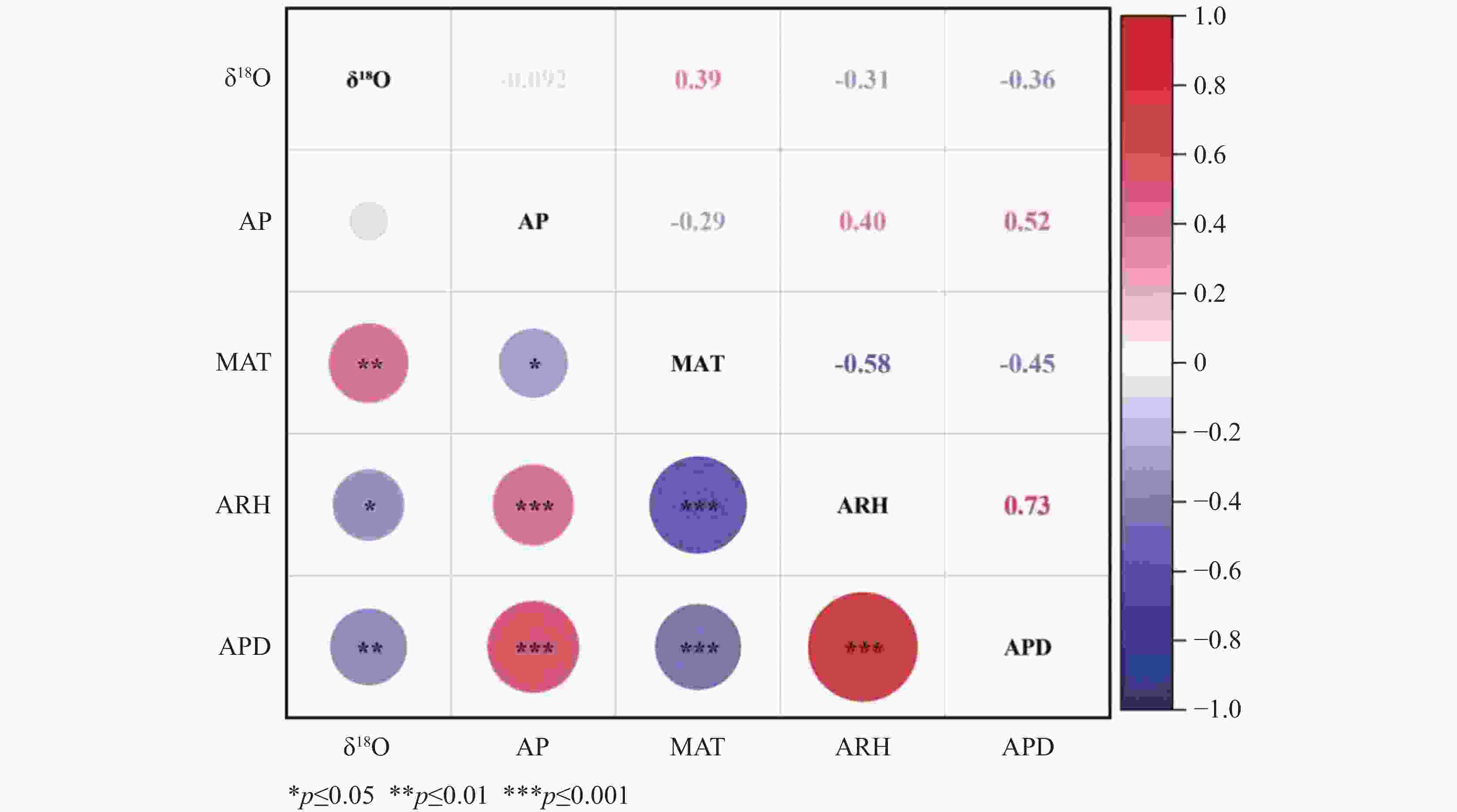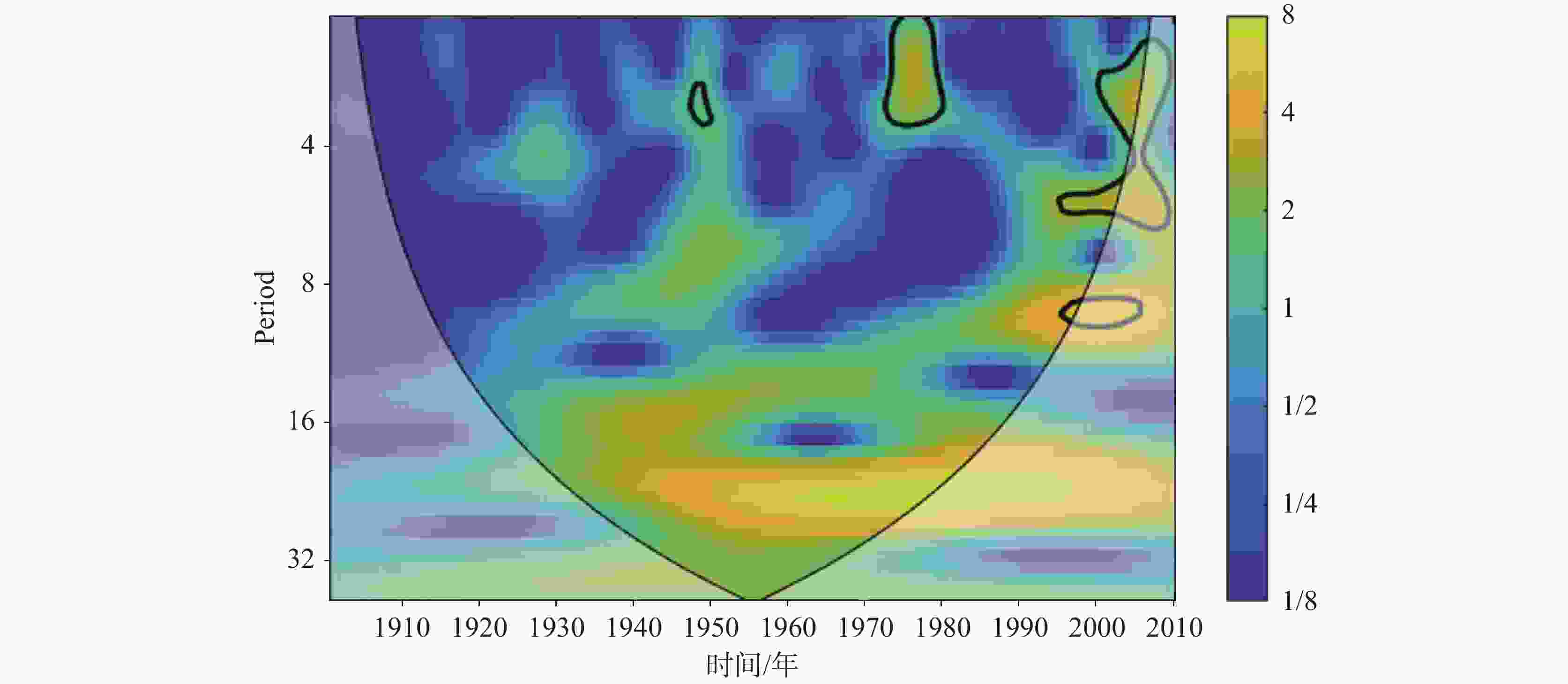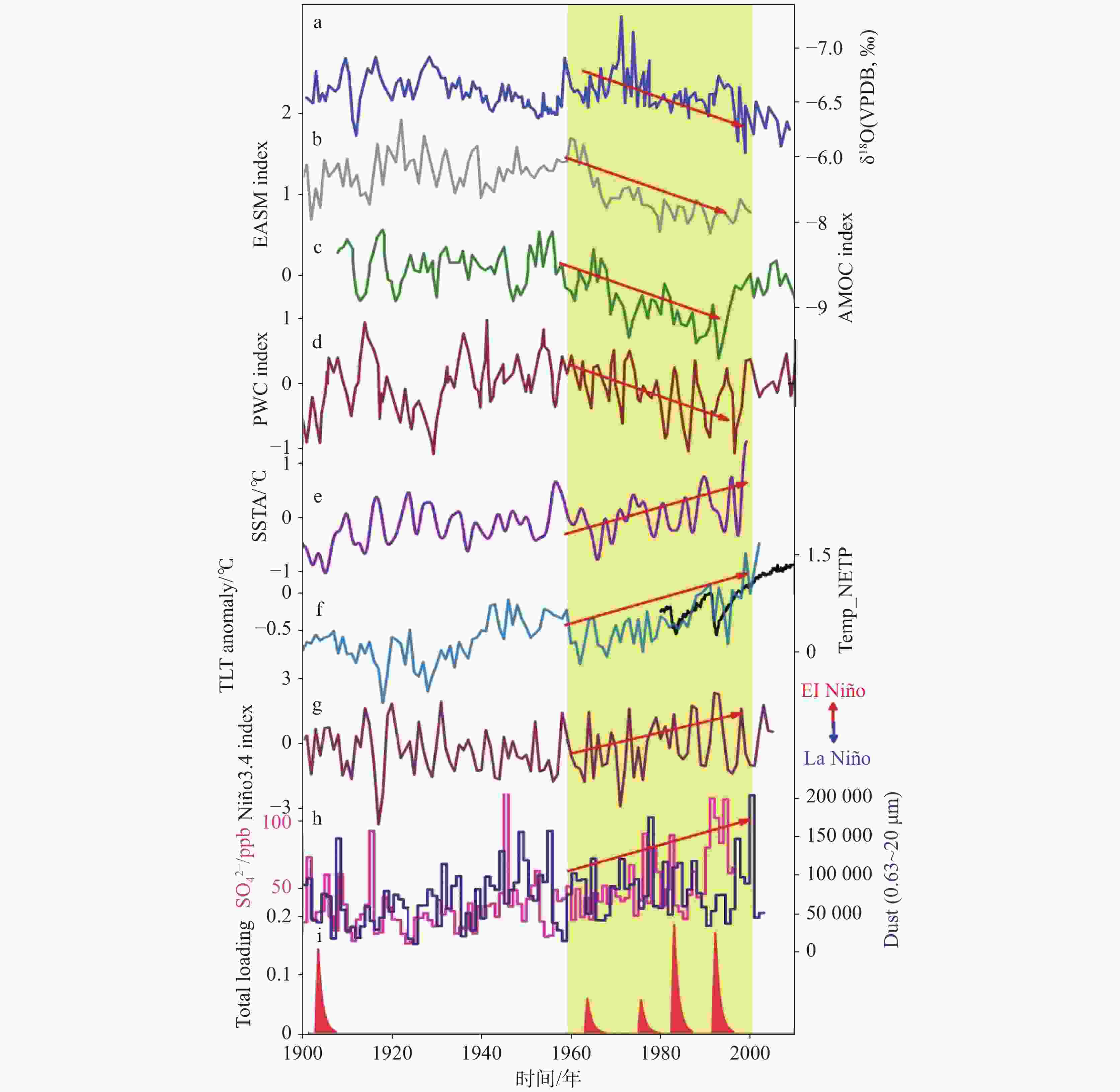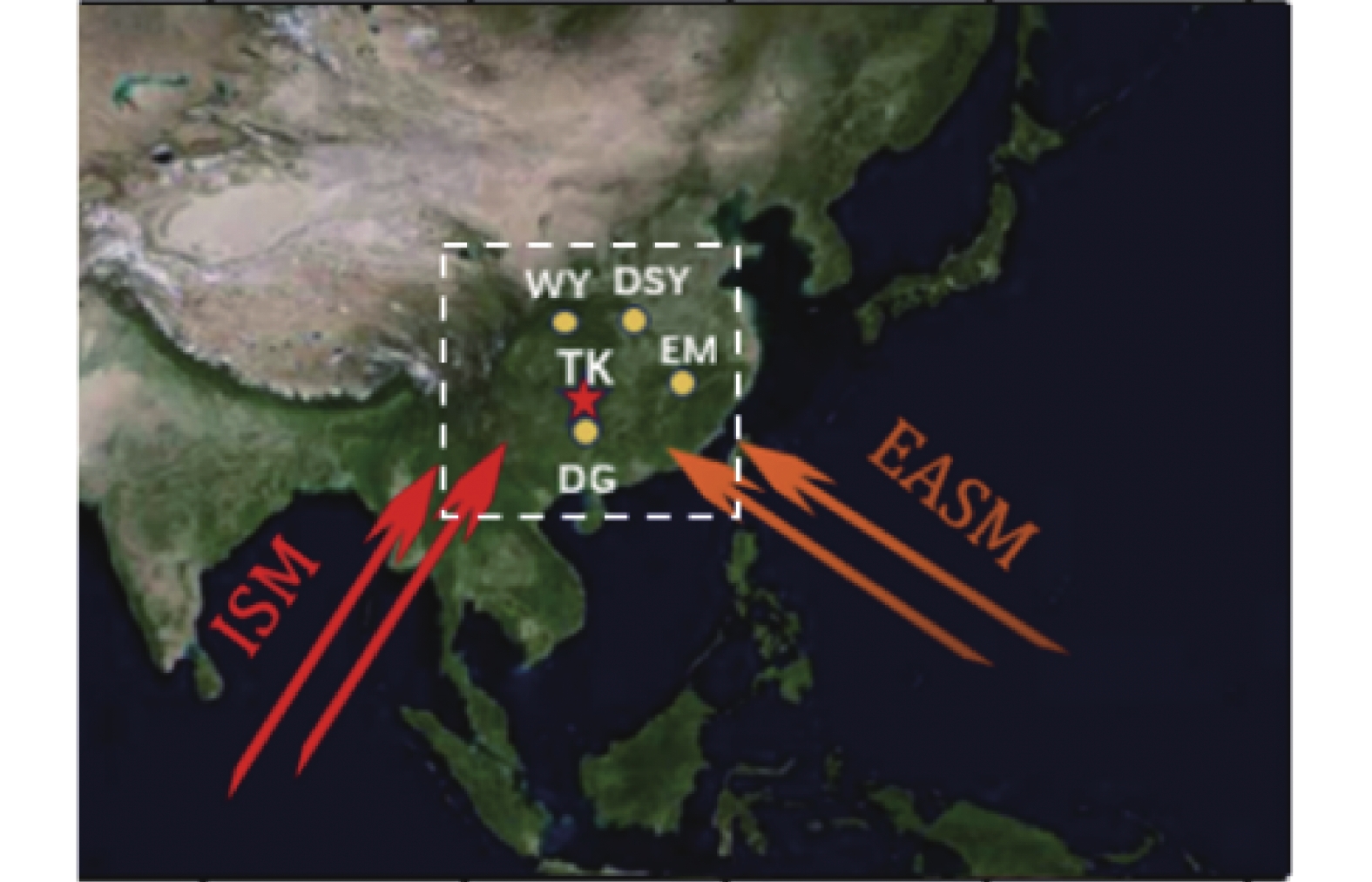Monsoon climate variability over the past century recorded by laminae stalagmite δ18O from southeastern Chongqing,China
-
摘要: 以重庆市酉阳自治县天坑洞采集的石笋样本TK22-1为研究对象,通过高精度的230Th测年和石笋纹层计数法,构建了覆盖近百年历史的高分辨率δ18O序列。研究发现,石笋TK22-1δ18O变化与年平均温度显著正相关,与年平均湿度和年降水天数显著负相关,与年降水量呈负相关关系,但未达到显著性水平,但与当地干旱事件密切相关。表明与温度、降雨天数和湿度相关的区域水文状况是影响石笋δ18O的主要因素。石笋TK22-1的δ18O记录显示,过去100年亚洲夏季风(East Asian Summer Monsoon, EASM)持续减弱,尤其在20世纪80年代后,减弱趋势在中国季风区尤为显著,该现象的形成是自然因素与人为因素共同作用的结果。与全球其他气候指标对比,发现亚洲夏季风减弱与全球气温升高、厄尔尼诺-南方涛动(El Niño-Southern Oscillation,ENSO)极端事件增多、大西洋经向翻转环流(Atlantic Meridional Overturning Circulation,AMOC)与太平洋沃克环流(Pacific Walker Circulation,PWC)减弱等现象有关,特别是温室气体排放,通过影响ENSO、AMOC和PWC等气候系统关键环节,间接导致了亚洲夏季风强度的减弱。Abstract:
This study adopted the stalagmite sample TK22-1 collected from Tiankeng Cave in Youyang Autonomous County, Chongqing, China, as the research object. A high-resolution δ18O sequence spanning the past century was reconstructed through a combination of high-precision 230Th dating and stalagmite laminae counting. This study reveals that the δ18O values of stalagmite TK22-1 exhibited a range of -6.03‰ to -7.29‰, with a mean value of -6.57‰. The positive shifts of δ18O (peaks) correspond well with recorded major drought events in the Sichuan-Chongqing region, such as the 2006 summer drought and the 1960 drought disaster. Correlation analyses show that δ18O variations exhibit a significant positive correlation with annual mean temperature but significant negative correlations with both annual mean humidity and the number of annual precipitation days. Although negatively correlated with total annual precipitation, this relationship does not reach statistical significance. Notably, the δ18O record closely corresponds to local drought events, indicating that regional hydrological conditions-such as temperature, the number of precipitation days, and humidity-are the dominant factors influencing stalagmite δ18O values. The nearly 100-year stalagmite δ18O time series shows distinct phases: δ18O remained consistently negative from 1900 to 1910, shifted to positive between 1910 and 1960, briefly decreased from 1960 to 1970, and have exhibited a consistently positive trend since 1970. Principal component analysis demonstrates that the positive δ18O trend in stalagmites from the Chinese monsoon region is spatially widespread, with a significant weakening observed after 1980. The observed weakening of the Asian Summer Monsoon (ASM) results from a combination of natural variability, such as 11-year solar cycles and Pacific Decadal Oscillation phase shifts, and anthropogenic forcing including greenhouse gases and aerosols. The primary driving mechanisms including ENSO regime transitions, weakening of Atlantic Meridional Overturning Circulation (AMOC) and Pacific Walker Circulation (PWC), and aerosol effects. This trend is significantly associated with global rise in temperature, an increased frequency of extreme ENSO events, and the weakening of both the AMOC and the PWC. Wavelet analysis identifies significant ENSO-related periodicities (2 years to 7 years) in the δ18O record. Between 1960 and 2000, the ENSO system progressively shifted toward El Niño-like states, with Central Pacific (CP) El Niño events suppressing monsoon intensity. The weakening of AMOC reduces land-sea thermal gradients, while the weakening of PWC alters zonal sea surface temperature gradients; together, these changes diminish monsoon dynamics. -
Key words:
- stalagmite /
- oxygen isotope /
- monsoon climate change /
- laminae /
- influencing factor /
- Chongqing
-
图 1 亚洲季风区地形和大气环流系统
红色箭头指示印度夏季风(ISM,Indian Summer Monsoon)轨迹,橙色箭头指示东亚夏季风(EASM,East Asian Summer Monsoon)轨迹。天坑洞(TK,红星)及相关洞穴所在位置(黄色圆形),包括峨眉洞(EM)[16]、董哥洞(DG)[24]、东石崖洞(DSY)[25]、乌鸦洞(WY)[26]。
Figure 1. Topography and atmospheric circulation systems in the Asian Monsoon Region
Red arrow: trajectory of the Indian Summer Monsoon (ISM); orange arrow: trajectory of the East Asian Summer Monsoon (EASM); red star: location of Tiankeng Cave (TK);yellow circle: caves related to Tiankeng Cave, including Emei Cave(EM)[16], Dongge Cave(DG)[24], Dongshiya Cave(DSY)[25], and Wuya Cave(WY)[26].
图 5 亚洲季风区石笋记录与渝东南旱涝指数对比
(A) 天坑洞石笋TK22-1(本文) (B) 董哥洞石笋DX2[24] (C) 峨眉洞石笋EM1[16] (D) 东石崖洞石笋DSY1201[25] (E) 乌鸦洞石笋WY33[26] (F) 对TK22-1、DX2、EM1、DSY1201和WY33的主成分分析(PCA)结果 (G) 渝东南近100年旱涝指数(旱涝指数越大代表干旱程度越强)[33],图中红色曲线为多项式拟合曲线,指示变化趋势;蓝色条带指示研究区发生的干旱事件
Figure 5. Comparison of stalagmite records from the Asian Monsoon Region and the drought-flood indices in Southeastern Chongqing
(A)stalagmite TK22-1 from Tiankeng Cave in this study (B) stalagmite DX2 from Dongge Cave[24] (C) stalagmite EM1 from Emei Cave[16] (D) stalagmite DSY1201 from Dongshiya Cave [25] (E) stalagmite WY33 from Wuya Cave [26] (F) Principal Component Analysis (PCA) results of TK22-1, DX2, EM1, DSY1201, and WY33 (G) drought-flood indices of southeastern Chongqing over the past 100 years (higher values indicating greater drought severity) [33], red curve for the polynomial fitting curve indicating the variation trend,and blue band for drought events occurring in the study area
图 6 TK22-1石笋 δ18O、年降水量(annual precipitation, AP)、年平均气温(Mean Annual Temperature, MAT)、年相对湿度(Annual Relative Humidity, ARH)和年降水日数(Annual Precipitation Days, APD)相关性图
(颜色由浅到深色表示相关性由弱到显著,数字表示相关性系数)
Figure 6. Correlation diagram of δ18O, Annual Precipitation (AP), Mean Annual Temperature (MAT), Annual Relative Humidity (ARH), and the number of Annual Precipitation Days (APD) of stalagmite TK22-1
(The colors, ranging from light to dark, indicate the strength of the correlation from weak to strong, while the numbers represent the correlation coefficients.)
图 7 石笋TK22-1氧同位素序列与酉阳地区1950—2016年器测气象资料对比
(A)酉阳自治县年降水量 (B)酉阳自治县年平均温度 (C)酉阳自治县年平均湿度 (D)年降水量 (E)石笋TK22-1氧同位素序列
Figure 7. Comparison between the oxygen isotope sequence of stalagmite TK22-1 and the instrumental meteorological data in Youyang area from 1950 to 2016
(A) annual precipitation days (B) mean annual temperature (C) mean annual humidity (D)annual precipitation (E) oxygen isotope sequence of stalagmite TK22-1
图 9 亚洲夏季风记录与全球记录对比
(A)天坑洞石笋 TK22-1 δ18O记录(本文) (B) 东亚夏季风重建指数[41] (C)AMOC重建指数[42] (D) 太平洋沃克环流指数[43] (E)SST重建指数[44] (F)青藏高原东北部温度重建记录(浅蓝)[45],对流层温度重建(黑色)[46] (G)Niño3 区海表温度距平值[47] (H)达索普冰芯${\rm{SO}}_4^{2-} $(粉色)和灰尘粒子记录(紫色)[48] (I)火山气溶胶总负荷量(0~30°N)[49],图中黄色区域指示季风快速减弱发生时期
Figure 9. Comparison of Asian Summer Monsoon records with global records
(A) δ18O record of stalagmite TK22-1 from Tiankeng Cave in this study (B) reconstruction index of the East Asian Summer Monsoon[41] (C) reconstruction index of AMOC[42] (D) Pacific Walker Circulation Index[43] (E) reconstruction index of SST[44] (F) temperature reconstruction records in the northeastern Qinghai-Xizang Plateau(light blue)[45], and tropospheric temperature reconstruction (black)[46] (G) sea surface temperature anomaly in Niño3 region[47] (H) ${\rm{SO}}_4^{2-} $ (pink) and dust particle record (purple) in Dasuopu ice core[48] (I) total volcanic aerosol load (0 to 30°N)[49], and the periods of rapid monsoon weakening (yellow areas)
表 1 石笋 TK22-1230Th 测年结果
Table 1. 230Th dating results of the stalagmite TK22-1
样品编号
Sample
number深度
Depth/mm238U
(×10−9)232Th
(×10−12)230Th/232Th
(atomic×10−6)δ234U
(measured)230Th / 238U
(activity)δ234UInitial*
(corrected)已校正Corrected230Th
年龄(年 公元) 230Th
Age (a AD)TK22-1-1 6 1602.7 ±4.06707 ±1358±0 79.7±2.6 0.0019 ±0.0001 80±3 1935±81 TK22-1-1 11 1496.2 ±3.2931±39 19±2 82.5±2.2 0.0015 ±0.0002 82±2 1904±31 TK22-1-2 17 1691.3 ±3.9051±42 25±2 83.1±2.2 0.0019 ±0.0002 83±2 1861±29 *Th衰变常数为λ230=9. 1705 ×10−6a−1,U衰变常数为λ234=2.82206 ×10−6 a−1,λ238=1.55125 ×10−10 a−1;δ 234U = ([234U/238U]activity−1)×1000 。 根据230Th年龄获得δ234U初始值=δ234U测量值×eλ234×T。初始年龄校正采用230Th /232Th平均比值:4.4±2.2×10−6。 -
[1] IPCC. Climate Change 2022: Impacts, Adaptation and Vulnerability[M]. Cambridge University Press, 2022. [2] Wang Y, Cheng H, Edwards R L, Broecker W S, Dykoski C A, Li X M. Millennial- and orbital-scale changes in the East Asian monsoon over the past 224, 000 years[J]. Nature, 2008, 451(7182): 1090-1093. doi: 10.1038/nature06692 [3] Held I M, Soden B J. Robust responses of the hydrological cycle to global warming[J]. Journal of Climate, 2006, 19(21): 5686-5699. doi: 10.1175/JCLI3990.1 [4] An Z S, Kutzbach J E, Prell W L, Porter S C, Xiao J. Evolution of Asian monsoons and phased uplift of the Himalaya−Tibetan plateau since Late Miocene times[J]. Nature, 2001, 411(6833): 62-66. doi: 10.1038/35075035 [5] Yancheva G, Nowaczyk N R, Mingram J, Dulski P, Negendank J F W, Sinninghe Damsté J S. Influence of the intertropical convergence zone on the East Asian monsoon[J]. Nature, 2007, 445(7123): 74-77. doi: 10.1038/nature05431 [6] 成永生, 肖想, 余子俊,罗忠行,曾德兴,廖先平,李望月,陈鑫,刘舟, 吴非易,张俊. 湘西吉首岩溶区土壤有机质富集特征及其关键影响因素 [J/OL]. 中国岩溶, 2025, 1-19[2025-02-28]. https://www.cnki.net/.CHENG Yongsheng, XIAO Xiang, YU Zijun, LUO Zhongxing, ZENG Dexing, LI Wangyue, CHEN Xin, LIU Zhou,WU Feiyi, ZHANG Jun. Enrichment characteristics and key influencing factors of soil organic matter in the karst region of Jishou, Xiangxi, Western Hunan[J/OL]. Carsologica Sinica, 2025, 1-19 [2025-02-28]. https://www.cnki.net/. [7] 朱德根, 杨慧, 赵虎,史邵亮,吴秀芹, Mitija Prelovšek,Nataša Ravbar.广西岩溶区石漠化演变及其对土地利用变化的响应[J/OL]. 中国岩溶, 2025, 1-22.[2024-12-02]. https://www.cnki.net/.ZHU Degen, YANG Hui, ZHAO Hu,WU Xiuqin, Mitija Prelovšek, Nataša Ravbar. Evolution of rocky desertification and its response to land use changes in the karst region of Guangxi, Southwest China[J/OL]. Carsologica Sinica, 2025, 1-22[2024-12-02]. https://www.cnki.net/. [8] 江峰, 吉勤克补子, 曹建文,王若帆,赵良杰. 黔中岩溶区地下水水化学来源特征及其影响因素[J]. 中国岩溶, 2024, 43(4): 889-899.JIANG Feng, JIQIN Kebuzi, CAO Jianwen, WANG Ruofan, ZHAO Liangjie. Hydrochemical sources and controlling factors of groundwater in the karst region of central Guizhou, Southwest China[J]. Carsologica Sinica, 2024, 43(4): 889-899. [9] Tan M, Liu T S, Hou J Z, Cai Y J, Shen C C. Cyclic rapid warming on centennial-scale revealed by a 2650-year stalagmite record of warm season temperature[J]. Geophysical Research Letters, 2003, 30(12): 1617. [10] Yang X L, Yang H, Wang B Y, Cheng H, Edwards R L, Zhang M. Early-Holocene monsoon instability and climatic optimum recorded by Chinese stalagmites[J]. The Holocene, 2019, a,29(4): 1-9. [11] Yang X L, Liu J B, Liang F Y, Cheng H, Edwards R L, Zhang M. Holocene stalagmite δ18O records in the East Asian monsoon region and their correlation with those in the Indian monsoon region[J]. The Holocene, 2014(12):1657-1664. [12] Maher B A. Holocene variability of the East Asian summer monsoon from Chinese cave records: A re-assessment[J]. The Holocene, 2008, 18(6): 861-866. doi: 10.1177/0959683608095569 [13] Maher B A, Thompson R. Oxygen isotopes from Chinese caves: records not of monsoon rainfall but of circulation regime[J]. Journal of Quaternary Science, 2012, 27(6): 615-624. doi: 10.1002/jqs.2553 [14] 殷建军, 唐伟. 桂林茅茅头大岩近50年来石笋 δ18O 记录与局地气候大尺度环流关系探讨[J]. 地质学报, 2016, 90(8): 2035-2042. doi: 10.3969/j.issn.0001-5717.2016.08.030YIN Jianjun, TANG Wei. Relationship between stalagmite δ18O records from Maomaotou Cave, Guilin over the past 50 years and large-scale atmospheric circulation-local climate interactions[J]. Acta Geologica Sinica, 2016, 90(8): 2035-2042. doi: 10.3969/j.issn.0001-5717.2016.08.030 [15] Li X, Cheng H, Tan L, Edwards R L, Shen C C, Zhang M. The East Asian summer monsoon variability over the last 145 years inferred from the Shihua Cave record [J]. North China, 2017, Sci Rep7: 7078. [16] Zhang H, Cheng H, Spötl C, Edwards R L, Shen C C, Wang Y. A 200-year annually laminated stalagmite record of precipitation seasonality in southeastern China and its linkages to ENSO and PDO [J]. Sci Rep 8, 2018: 12344. [17] TAN L C, SHEN C C, Löwemark L, CHENG H, Edwards R L, Wang Y. Rainfall variations in central Indo-Pacific over the past 2, 700 yr[J]. Proceeding of the National Academy Sciences, 2019, 116: 17201-17206. doi: 10.1073/pnas.1903167116 [18] 李廷勇. 伪雨量效应—— 一个同位素气候学问题的讨论[J]. 第四纪研究, 2018, 38(6): 1545-1548. doi: 10.11928/j.issn.1001-7410.2018.06.20LI Tingyong. Pseudo-amount effect: revisiting a critical question in isotope climatology[J]. Quaternary Sciences, 2018, 38(6): 1545-1548. doi: 10.11928/j.issn.1001-7410.2018.06.20 [19] Nan S, Tan M, Zhao P, Liu X, Cai Y. Evaluation of the ability of the Chinese stalagmite δ18O to record the variation in atmospheric circulation during the second half of the 20th century[J]. Clim Past, 2014, 10(3): 975-985. doi: 10.5194/cp-10-975-2014 [20] Tan M, Liu X, Cai Y, Zhao P. Circulation effect: response of precipitation δ18O to the ENSO cycle in monsoon regions of China[J]. Climate dynamics, 2014, 42(3): 1067-1077. [21] 谭明. 环流效应: 中国季风区石笋氧同位素短尺度变化的气候意义: 古气候记录与现代气候研究的一次对话[J]. 第四纪研究, 2009,29(5):851-862.TAN Ming. Circulation Effect: climatic significance of short-term variability in stalagmite δ18O from the Chinese monsoon region — bridging paleoclimate records and modern climate dynamics[J]. Quaternary Sciences, 2009,29(5):851-862. [22] Ruan J Y, Zhang H Y, Cai Z Y, Liu, X M, Huang C Y. Regional controls on daily to interannual variations of precipitation isotope ratios in Southeast China: Implications for paleomonsoon reconstruction[J]. Earth and Planetary Science Letters, 2019, 527: 115794. doi: 10.1016/j.jpgl.2019.115794 [23] WANG Y J, CHENG H, Edwards R L,AN Z, WU J Y, SHEN C C, Dorale J A . A high-resolution absolute-dated late Pleistocene monsoon record from Hulu Cave, China[J]. Science, 2001, 294(5550): 2345-2348. doi: 10.1126/science.1064618 [24] Zhao K, Wang Y J. , Edwards R L, Cheng H, Shen C C, & Zhang M. A high-resolved record of the Asian Summer Monsoon from Dongge Cave, China for the past 1200 years[J]. Quaternary Science Reviews, 2015, 122: 250-257. doi: 10.1016/j.quascirev.2015.05.030 [25] Zhao J, Cheng H, Yang Y, Edwards R L, Shen C C, Wang Y. Reconstructing the western boundary variability of the Western Pacific Subtropical High over the past 200 years via Chinese cave oxygen isotope records[J]. Quaternary Science Reviews, 2019, 52: 3741-3757. [26] Tan L, An Z, Huh C A, Cheng H, Edwards R L, Shen C C. Cyclic precipitation variation on the western Loess Plateau of China during the past four centuries[J]. Scientific Reports, 2014, 4: 6381. doi: 10.1038/srep06381 [27] Shen C Z, Wu C C, Cheng H, Edwards R L, Hsieh Y T, Gallet S, Chang C C, Li T Y, Lam D D, Kano A. High-precision and high-resolution 230Th dating for coral and speleothem carbonates by MC-ICP-MS with SEM protocols[J]. Geochimica et Cosmochimica Acta, 2012, 99: 71-86. doi: 10.1016/j.gca.2012.09.018 [28] 殷建军, 李红春, 沈川洲, 李廷勇, 林玉石, 覃嘉铭, 唐伟, 王华, 杨会. 年轻石笋平均沉积速率的确定: 多方法探讨[J]. 地质学报, 2015, 89(10): 1884-1891. doi: 10.3969/j.issn.0001-5717.2015.10.015YIN Jianjun, LI Hongchun, SHEN Chuanzhou, LI Tingyong, LIN Yushi, QIN Jiaming, TANG Wei, WANG Hua, YANG Hui. Determining average growth rates of young stalagmites: A multi-method approach[J]. Acta Geologica Sinica, 2015, 89(10): 1884-1891. doi: 10.3969/j.issn.0001-5717.2015.10.015 [29] 张德二, 刘传志. 《中国近五百年旱涝分布图集》续补 (1980-1992 年)[J]. 气象, 1993(11): 41-45. doi: 10.7519/j.issn.1000-0526.1993.11.009ZHANG De'er, LIU Chuanzhi. Continuation and supplementation of "Atlas of Drought and Flood Distribution in China in the Past Five Hundred Years" (1980-1992)[J]. Meteorology, 1993(11): 41-45. doi: 10.7519/j.issn.1000-0526.1993.11.009 [30] 张德二, 李小泉, 梁有叶. 《中国近五百年旱涝分布图集》的再续补 (1993-2000 年)[J]. 应用气象学报, 2003, 14(3): 397-388.ZHANG De'er, LI Xiaoquan, LIANG Youye. Further continuation and supplementation of "Atlas of Drought and Flood Distribution in China in the Past Five Hundred Years" (1993-2000)[J]. Journal of Applied Meteorological Science, 2003, 14(3): 397-388. [31] 中央气象局气象科学研究院. 中国近五百年旱涝分布图集[M]. 北京: 地图出版社, 1981: 321-332.Meteorological Science Research Institute of the Central Meteorological Bureau. Atlas of drought and flood distribution in China in the past five hundred years[M]. Beijing: Cartographic Publishing House, 1981: 321-332. [32] 董西瑀, 程海, Kathayat G, Edwards R L, Sinha A, Wang Y. 石笋记录的印度季风Heinrich 2 事件结束过程[J]. 第四纪研究, 2019, 39(4): 878-893. doi: 10.11928/j.issn.1001-7410.2019.04.08DONG Xiyu, CHENG Hai, Kathayat G, Edwards R L, Sinha A, Wang Y. The end process of the Heinrich 2 event of the Indian monsoon recorded by stalagmites[J]. Quaternary Sciences, 2019, 39(4): 878-893. doi: 10.11928/j.issn.1001-7410.2019.04.08 [33] 钱维宏, 朱亚芬, 汤帅奇. 重建千年东亚夏季风干湿分布型指数[J]. 科学通报, 2011, 56(25): 2075-2082. doi: 10.1360/csb2011-56-25-2075QIAN Weihong, ZHU Yafen, TANG Shuaiqi. Reconstruction of the aridity-humidity distribution index of the east Asian summer monsoon over the past thousand years[J]. Chinese Science Bulletin, 2011, 56(25): 2075-2082. doi: 10.1360/csb2011-56-25-2075 [34] Zhang H W, Ait-Brahim Y, Li L L, Cheng H, Edwards R L, Shen C C. The Asian Summer Monsoon: Teleconnections and Forcing Mechanisms—A Review from Chinese Speleothem δ18O Records[J]. Quaternary, 2019, 2(3): 26. doi: 10.3390/quat2030026 [35] Li H, Dai A, Zhou T, Trenberth K E, Jones P D. Responses of East Asian summer monsoon to historical SST and atmospheric forcing during 1950−2000[J]. Climate Dynamics, 2010, 34: 501-514. doi: 10.1007/s00382-008-0482-7 [36] Chen X M, Jiang X Y, Wang X G, Zhao J Y, Sun Z, Li Y D, Ye Z M, Cai J R, Fu X, Xu Y Z, Yang Y. New insights into potential effects of solar activity on the oxygen isotope composition of modern speleothems: Observations from Jiguan Cave, central China II[J]. Journal of Hydrology, 2023, 625(B): 130114. [ISSN 0022-1694] [37] Fairchild I J, Baker A. Speleothem Science: From Process to Past Environments [M]. Wiley-Blackwell, 2012. [38] Liu M, Xu X, Wang D. Karst catchments exhibited higher degradation stress from climate change than the non-karst catchments in southwest China: An ecohydrological perspective[J]. Journal of Hydrology, 2016, 535: 173-180. doi: 10.1016/j.jhydrol.2016.01.033 [39] 张日萍, 杨勋林, 张瑞. 重庆金佛洞石笋灰度气候环境意义及全新世千年尺度事件[J]. 第四纪研究, 2020, 40(4): 936-944. doi: 10.11928/j.issn.1001-7410.2020.04.09ZHANG Riping, YANG Xunlin, ZHANG Rui. Climatic and environmental significance of stalagmite gray-scale and Holocene millennial-scale events in Jinfo Cave, Chongqing[J]. Quaternary Sciences, 2020, 40(4): 936-944. doi: 10.11928/j.issn.1001-7410.2020.04.09 [40] 张瑞, 杨勋林, 刘秀明, 殷建军, 刘睿恺, 王宝艳. 渝东南近 100 年石笋灰度变化及气候环境意义[J]. 生态学报, 2019, 39(16): 6098-6106.ZHANG Rui, YANG Xunlin, LIU Xiuming, YIN Jianjun, LIU Ruikai, WANG Baoyan. Changes in stalagmite gray-scale in southeastern Chongqing over the past 100 years and their climatic and environmental significance[J]. Acta Ecologica Sinica, 2019, 39(16): 6098-6106. [41] 郭其蕴, 蔡静宁, 邵雪梅, 沙万英. 1873-2000 年东亚夏季风变化的研究[J]. 大气科学, 2004, 28(2): 206-215. doi: 10.3878/j.issn.1006-9895.2004.02.04GUO Qiyun, CAI Jingning, SHAO Xuemei, SHA Wanying. A study on the variation of the east Asian summer monsoon during 1873-2000[J]. Chinese Journal of Atmospheric Sciences, 2004, 28(2): 206-215. doi: 10.3878/j.issn.1006-9895.2004.02.04 [42] Zhao J, Cheng H, Cao J. Orchestrated decline of Asian summer monsoon and Atlantic meridional overturning circulation in global warming period[J]. The Innovation Geoscience, 2023, 1(1): 100011. [43] Falster G, Konecky B, Coats S. Forced changes in the Pacific Walker circulation over the past millennium[J]. Nature, 2023, 622: 93-100. doi: 10.1038/s41586-023-06447-0 [44] Pahnke K, Zahn R, Elderfield H, Schulz M. 340, 000-Year Centennial-Scale Marine Record of Southern Hemisphere Climatic Oscillation[J]. Science, 2003, 301(5635): 948-952. doi: 10.1126/science.1084451 [45] Xu G B, Liu X H, Zhang Q. Century scale temperature variability and onset of industrial era warming in the Eastern Tibetan Plateau [J]. Climate Dynamics, 2019, 53 (7-8). [46] Santer B, Bonfils C, Painter J. Volcanic contribution to decadal changes in tropospheric temperature[J]. Nature Geoscience, 2014, 7: 185-189. doi: 10.1038/ngeo2098 [47] Santoso A. Late-twentieth-century emergence of the El Niño propagation asymmetry and future projections[J]. Nature, 2013, 504: 126-130. doi: 10.1038/nature12683 [48] 王宁练, 姚檀栋, Thompson L G, Davis M E. 近 500 年来喜马拉雅山达索普冰芯中尘埃含量变化与西、南亚及北非干旱化趋势[J]. 第四纪研究, 2012, 32 (1): 53-58.WANG Ninglian, YAO Tandong, Thompson, L G, Davis M E. Changes in dust content in the Dasuopu ice core on the Himalayas over the past 500 years and the aridification trends in West Asia, South Asia and North Africa [J]. Quaternary Sciences, 2012, 32 (1): 53-58. [49] Schmidt G A, Jungclaus J H, Ammann C M. Climate forcing reconstructions for use in PMIP simulations of the Last Millennium (v1.0)[J]. Geoscientific Model Development, 2011, 4(3): 1549-1586. [50] Zhang J, Liang M Q. Asian-Australian monsoon evolution over the last millennium linked to ENSO in composite stalagmite δ18O records [J]. Quaternary Science, 2022, 107420. [51] 胡春迪. 全球变化背景下厄尔尼诺的模态变异及其与东亚和北极夏季气候异常的遥相关关系[D]. 南京: 南京大学, 2016.HU Chundi. Modal variations of El Niño under the background of global change and its teleconnection with abnormal summer climates in east Asia and the Arctic [D]. Nanjing: Nanjing University, 2016. [52] Freund M B, Henley B J, Karoly D J. Higher frequency of Central Pacific El Niño events in recent decades relative to past centuries[J]. Nature Geoscience, 2019, 12: 450-455. doi: 10.1038/s41561-019-0353-3 [53] Bellomo K, Meccia V L, D’Agostino, R. Impacts of a weakened AMOC on precipitation over the Euro-Atlantic region in the EC-Earth3 climate model[J]. Climate Dynamics, 2023, 61: 3397-3416. doi: 10.1007/s00382-023-06754-2 [54] Jackson L C, Biastoch A, Buckley M W. The evolution of the North Atlantic Meridional Overturning Circulation since 1980[J]. Nature Review Earth & Environment, 2022, 3: 241-254. doi: 10.1038/s43017-022-00263-2 [55] Zhang R, Delworth T L. Simulated Tropical Response to a Substantial Weakening of the Atlantic Thermohaline Circulation[J]. Journal of Climate, 2005, 18: 1853-1860. doi: 10.1175/JCLI3460.1 [56] Cheng H, Li H Y, Sha L J. Milankovitch theory and monsoon[J]. The Innovation, 2022, 3: 100338. [57] Cheng H, Zhang H, Cai Y. Orbital-scale Asian summer monsoon variations: Paradox and exploration[J]. Science China Earth Sciences, 2021, 64: 529-544. doi: 10.1007/s11430-020-9720-y [58] Cheng H, Xu Y, Dong X. Onset and termination of Heinrich Stadial 4 and the underlying climate dynamics[J]. Communicaions Earth & Environment, 2021, 2: 230. doi: 10.1038/s43247-021-00304-6 [59] Gabrielli P, Wegner A, Sierra-Hernández, M. Early atmospheric contamination on the top of the Himalayas since the onset of the European Industrial Revolution[J]. Proceedings of the National Academy of Sciences, 2020, 117(8): 201910485. [60] Kang J M, Shaw T A, Sun L. Anthropogenic Aerosols Have Significantly Weakened the Regional Summertime Circulation in the Northern Hemisphere During the Satellite Era [J]. AGU, 2024,5(6):e2024AV001318. [61] Kaspi Y, Schneider T. "The Role of Stationary Eddies in Shaping Midlatitude Storm Tracks. " Journal of the Atmospheric Sciences, 2013, 70 (7): 2007-2021. [62] Liu Y, Cai W J, Sun C F, Song H M, Cobb K. M. Anthropogenic Aerosols Cause Recent Pronounced Weakening of Asian Summer Monsoon Relative to Last Four Centuries[J]. Geophysical Research Letters, 2019, 10(6):527-542. [63] 谭明. 近千年气候格局的环流背景: ENSO 态的不确定性分析与再重建[J]. 中国科学: 地球科学, 2016, 46(5): 657-673. doi: 10.1360/N072015-00078TAN Ming. Circulation background of the climate pattern in the past millennium: Uncertainty analysis and reconstruction of the ENSO state[J]. Scientia Sinica (Terrae), 2016, 46(5): 657-673. doi: 10.1360/N072015-00078 [64] CAI W J, Borlace S, Lengaigne M,. Increasing frequency of extreme El Niño events due to greenhouse warming[J]. Nature Climate Change, 2014, 4: 111-116. doi: 10.1038/nclimate2100 [65] Tokinaga H, Xie S P, Deser C. Slowdown of the Walker circulation driven by tropical Indo-Pacific warming[J]. Nature, 2012, 491: 439-443. doi: 10.1038/nature11576 [66] Nobre P, Veiga S F, Giarolla E. AMOC decline and recovery in a warmer climate[J]. Scientic Reports, 2023, 13: 15928. doi: 10.1038/s41598-023-43143-5 -




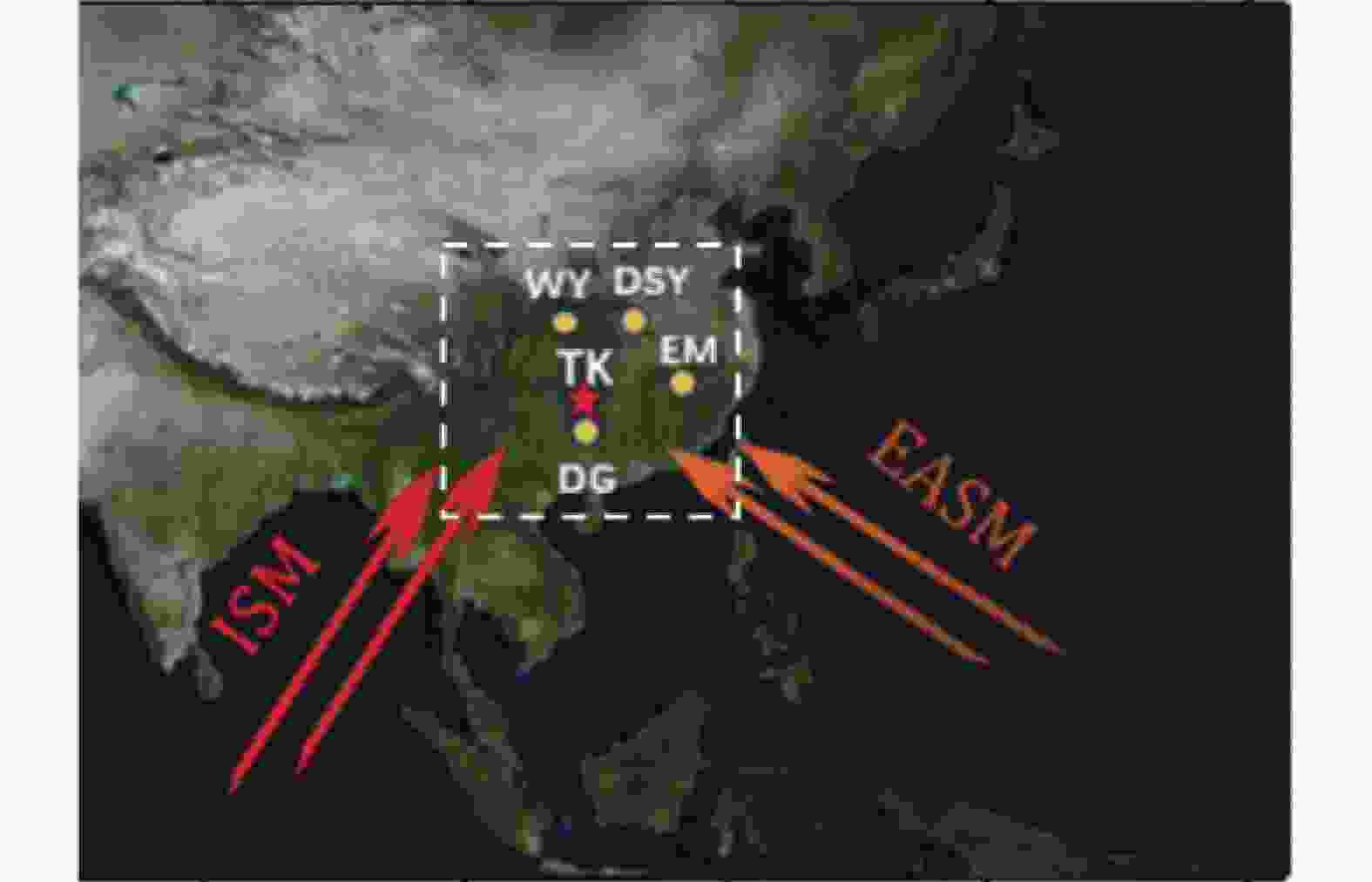
 下载:
下载:

